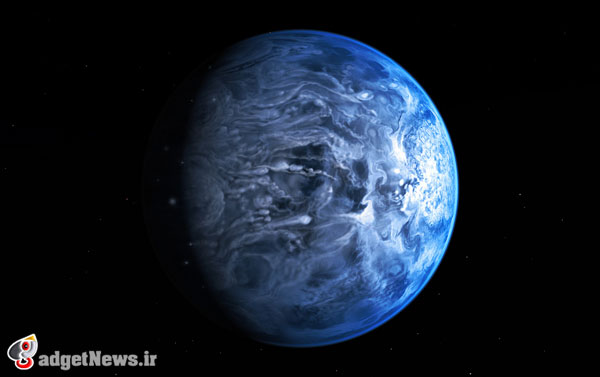
تلسکوپ فضایی هابل سطح آبینگ سیاره ژوپیترمانند و غولپیکر HD 189733b را رصد کرده که از فضا تفاوت چندانی با زمین ندارد و شباهت آن با سیاره خاکی به همین جا ختم میشود.این جرم کیهانی هر 2.2 روز یک بار حول ستاره والدش میچرخد و در فاصله 63 سال نوری از زمین در مجمعالکواکب Vulpecula (روباه) واقع شده است.
هنگامی که این سیاره در اطراف ستاره میزبانش میچرخید، منجمان از طیفنگار جداکننده نور هابل برای بررسی طولموجهای خاص نوری که از سطح آن ساطع میشوند، بهره بردند.این شی "سیاره عابر" (transiting planet) خوانده میشود زیرا به نسبت خط دید تلسکوپ از مقابل و سپس از پشت ستاره میزبانش عبور میکند.
زمانی که جرم مزبور از پشت ستارهاش گذر میکرد، نور رصدشده توسط هابل به طور عمیقی به درون بخش آبینگ طیفسنج الکترومغناطیسی نفوذ کرد، در حالی که دیگر رنگها به همان صورت باقی ماندند و این نشانهای از رنگ سیاره بود.
این سیاره برای داشتن آب مایع بیش از اندازه داغ است، اما مولکولهای دیگری وجود دارند که نور آبی را میافشانند و آن چه را که در جو زمین رخ میدهد، تقلید میکنند.دانشمندان معتقدند HD 189733b دارای ابرهایی است که از شیشه مایع تشکیل شدهاند.
به گفته فردریک پونت از دانشگاه اکستر انگلستان، منجمان بر این باورند که این رنگ به دلیل ترکیبی از انعکاس ابرهای سیلیکات و جذب توسط اتمهای سدیم به وجود میآید.دیگر عوامل میتوانند توسط آئروسولهای فتوشیمایی (مه) و جذب توسط دیگر اتمها یا مولکولهایی به جز سدیم به وجود آیند.
در حال حاضر هیچ کاندیدای خاصی برای این اتمها یا مولکولها وجود ندارد.موقعیت سیاره مورد مطالعه به طور باورنکردنی 30 برابر نزدیکتر به ستاره میزبانش در مقایسه با موقعیت زمین نسبت به خورشید است.در این فاصله، دمای سطح به بیش از یک هزار و 800 درجه فارنهایت میسد.به نظر میسد این سیاره از لحاظ گرانشی حبس شده، به طوری که یک سوی آن به طور دائم رو به ستارهاش است در حالی که طرف دیگر در تاریکی به سر میبرد.این دوگانگی میتواند بادهای وحشتناکی را خلق کند که سرعت آنها از چهار هزار و 350 مایل در ساعت تجاوز کند.
جزئیات این مطالعه در تاریخ یک آگوست در Astrophysical Journal Letters منتشر خواهد شد.
جهت دریافت تصویر این سیاره در ابعاد مختلف به این صفحه مراجعه فرمایید
منبع : space
Strange Blue World: Alien Planet's True Color Revealed, a First
Call it the deep blue dot. For the first time, scientists have seen the visible color of a distant alien world. The exoplanet — called HD 189733b — is 63 light-years from Earth and a "deep cobalt blue," with raging storms of glass rain and super-fast winds, scientists say.
The alien planet's blue color was pinned down using observations from the Hubble Space Telescope. Although the planet might be the same color as Earth from space, scientists think that HD 189733b is a "hot Jupiter" — a gas giant planet that orbits very close to its star. It takes 2.2 Earth days for the planet to travel fully around its sun.
"This planet has been studied well in the past, both by ourselves and other teams," said Frédéric Pont of the University of Exeter, U.K., leader of the Hubble observing program in a statement. "But measuring its color is a real first — we can actually imagine what this planet would look like if we were able to look at it directly."[See More Images of the Blue Alien Planet HD 189733b]
The exoplanet's weather is less than ideal. Its atmosphere is more than 1,832 degrees Fahrenheit (1,000 degrees Celsius) and the planet rains glass sideways in 4,350 mile per hour (7,000 km/h) winds, according to Hubble officials.
In 2007, NASA's Spitzer Space Telescope helped scientists map the weather conditions of the strange alien planet when the spacecraft produced one of the first temperature maps of an exoplanet. The data revealed that temperatures on the day and night sides of the world differ by about 500 degrees Fahrenheit (260 degrees Celsius), causing the strong winds to blow.
Scientists aren't sure what causes the blue planet's coloration, however.
"It's difficult to know exactly what causes the color of a planet's atmosphere, even for planets in the solar system," Pont said. "But these new observations add another piece to the puzzle over the nature and atmosphere of HD 189733b. We are slowly painting a more complete picture of this exotic planet."
The research team uncovered the planet's color by measuring the light reflected off the surface of the planet.
"We saw the brightness of the whole system drop in the blue part of the spectrum when the planet passed behind its star," Tom Evans of the University of Oxford, U.K., the leader of the study being published in the Aug. 1 issue of the journal Astrophysical Journal Letters said in a statement. "From this, we can gather that the planet is blue, because the signal remained constant at the other colors we measured."
 گجت نیوز آخرین اخبار تکنولوژی، علم و خودرو
گجت نیوز آخرین اخبار تکنولوژی، علم و خودرو 





